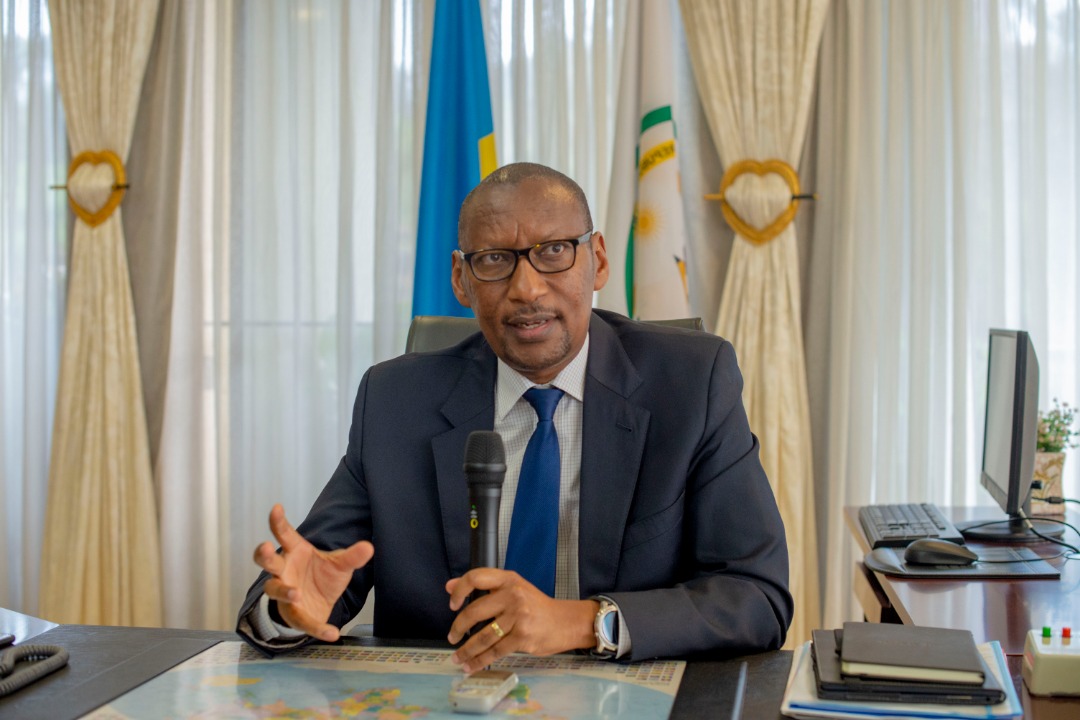
John Rwangombwa, Governor of Central Bank
The National Bank of Rwanda (BNR) has maintained the Central Bank Rate (CBR) at 4.5 percent with confidence in a progressive economic recovery that will largely be driven by stability in the financial sector.
The rate detention was announced today by the BNR Governor, John Rwangombwa, after a statutory quarterly Monetary Policy Committee (MPC) meeting held on 10th November 2021 which reviewed the impact of its previous decisions and assessed recent economic developments at the global and domestic level, as well as the outlook.
The MPC showed that despite the COVID19 pandemic which slapped the economic activities into a slump, the real GDP grew from -12.4% in 2020 quarter 2 (Q2) to 20.6% in this year in the same period year- on- year.
“The continued recovery of Rwanda’s economy is supported by sizable fiscal and monetary policy measures/ stimulus (Economic recovery funds and external borrowing), good agricultural performance with good harvest in 2021 season B and continued vaccine rollout,” the report said.
“The economy will continue to grow in the third quarter by 10.3% driven by industry and services and we will see growth even if we cannot pin on any specific number now,” Governor Rwangombwa said.
Economic Resilience
Even without a specific figure above, the MPC also showed some good news happening in the Rwandan economy despite COVID-19.
For instance, the growth in financial sector assets was driven by the progressive recovery of economic activities, which saw customer deposits, pension contributions, and insurance premiums grow significantly.
The other good news was seen in Rwanda’s trade deficit improving driven by higher exports in which merchandise exports improved by 58% offsetting the 12.7% growth in merchandise imports.
This was mainly driven by rising commodity prices as the global economy recovers; good performance of domestic manufacturing activities and agriculture sector (horticulture), Recovery of domestic economic activities and international commodity and oil prices.
Rwangombwa said that this is good for Rwanda as the big growth in exports compared to imports comes with a reduction in trade balance.
Sound Financial Stability
The Financial Stability Committee (FSC) report stated that nothing much has changed however the banking sector remained dominant at 67.2% in 2021 (compared to 67.3% in 2020)followed by pension (16.7%) insurance sector and Micro finance institutions.
Also the FSC showed that during the pandemic payment systems continued to operate smoothly with money supply increasing by 15.8% and usage of digital payments continued to deepen mainly driven by mobile financial services.
This saw bank assets grow to Rwf4.9Trillion (Tn) from Rwf4.0Tn in 2020 as major earning assets of banks remain stable, while outstanding bank loans grew by 19.1% (from Rwf 2.4 Trillion to Rwf2.9trillion driven by improved growth of outstanding loans in line with increased new lending.
New loans increased to Rwf942 billion from Rwf791 billion in the same period- the rebound of new lending was supported by both demand and supply factors, which also left the sector sound and stable in non-performing loans capital adequacy ratio and liquidity coverage ratios.
MoMo Pay, Cashless drop
However, the FSC showed that growth in digital payments mainly driven by mobile financial services has started dropping as a result of reinstituting mobile payment charges which had been scrapped during the height of the pandemic to ease digital payments.
This saw merchants payments (MoMo Pay) decreasing since September 2021 after a 0.5% fee reinstatement in this year.
For instance, mobile money value transacted dropped from Rwf 5.6 billion to Rwf2.5billion despite an increase in subscriptions due to the cashless drive.
Governor Rwangombwa said that there is an ongoing survey to understand the causes and impact of the cashless drive, which will inform the government on the next decision to take, however he stated that the immediate solution will be to increase citizen mobilization and education.


